Potential Sources, Pollution, and Ecological Risk Assessment of Potentially Toxic Elements in Surface Soils on the North-Eastern Margin of the Tibetan Plateau
Abstract
:1. Introduction
2. Materials and Methods
2.1. Research Area
2.2. Sample Collected and Chemical Analysis
2.3. Evaluating the Pollution and Ecological Risks of PTEs in Soils
3. Results and Discussion
3.1. Spatial Distributions of PTE Concentrations
3.2. Sources of PTEs in the Soil
3.3. Variation of Igeo, Pi, NPI, and RI in the Soils of Study Areas
4. Conclusions
Author Contributions
Funding
Institutional Review Board Statement
Informed Consent Statement
Data Availability Statement
Acknowledgments
Conflicts of Interest
References
- Kabata-Pendias, A.; Pendias, H. Biogeochemistry of trace elements. Pwn Warszawa 1999, 400, 398. [Google Scholar]
- Cong, Z.; Kang, S.; Zhang, Y.; Li, X. Atmospheric wet deposition of trace elements to central Tibetan Plateau. Appl. Geochem. 2010, 25, 1415–1421. [Google Scholar] [CrossRef]
- Shao, D.; Zhan, Y.; Zhou, W.; Zhu, L. Current status and temporal trend of heavy metals in farmland soil of the Yangtze River Delta Region: Field survey and meta-analysis. Environ. Pollut. 2016, 219, 329–336. [Google Scholar] [CrossRef] [PubMed]
- Wu, J.; Lu, J.; Li, L.; Min, X.; Luo, Y. Pollution, ecological-health risks, and sources of heavy metals in soil of the north-eastern Qinghai-Tibet Plateau. Chemosphere 2018, 201, 234–242. [Google Scholar] [CrossRef]
- Padoan, E.; Romè, C.; Ajmone-Marsan, F. Bioaccessibility and size distribution of metals in road dust and roadside soils along a peri-urban transect. Sci. Total Environ. 2017, 601-602, 89–98. [Google Scholar] [CrossRef]
- Jin, Y.; O’Connor, D.; Ok, Y.S.; Tsang, D.C.; Liu, A.; Hou, D. Assessment of sources of heavy metals in soil and dust at children’s playgrounds in Beijing using GIS and multivariate statistical analysis. Environ. Int. 2019, 124, 320–328. [Google Scholar] [CrossRef]
- Kowalska, J.; Mazurek, R.; Gąsiorek, M.; Setlak, M.; Zaleski, T.; Waroszewski, J. Soil pollution indices conditioned by medieval metallurgical activity—A case study from Krakow (Poland). Environ. Pollut. 2016, 218, 1023–1036. [Google Scholar] [CrossRef]
- Wan, D.; Mao, X.; Jin, Z.; Song, L.; Yang, J.; Yang, H. Sedimentary biogeochemical record in Lake Gonghai: Implications for recent lake changes in relatively remote areas of China. Sci. Total Environ. 2019, 649, 929–937. [Google Scholar] [CrossRef]
- Kang, S.; Huang, J.; Wang, F.; Zhang, Q.; Zhang, Y.; Li, C.; Wang, L.; Chen, P.; Sharma, C.M.; Li, Q.; et al. Atmospheric Mercury Depositional Chronology Reconstructed from Lake Sediments and Ice Core in the Himalayas and Tibetan Plateau. Environ. Sci. Technol. 2016, 50, 2859–2869. [Google Scholar] [CrossRef]
- Wei, B.; Yang, L. A review of heavy metal contaminations in urban soils, urban road dusts and agricultural soils from China. Microchem. J. 2010, 94, 99–107. [Google Scholar] [CrossRef]
- Wang, P.; Cao, J.J.; Han, Y.M.; Jin, Z.D.; Wu, F.; Zhang, F. Elemental distribution in the topsoil of the Lake Qinghai catchment, NE Tibetan Plateau, and the implications for weathering in semi-arid areas. J. Geochem. Explor. 2015, 152, 1–9. [Google Scholar] [CrossRef]
- Deng, W.; Li, X.; An, Z.; Yang, L. The occurrence and sources of heavy metal contamination in peri-urban and smelting contaminated sites in Baoji, China. Environ. Monit. Assess. 2016, 188, 1–8. [Google Scholar] [CrossRef] [PubMed]
- González-Guzmán, R.; Inguaggiato, C.; Brusca, L.; González-Acevedo, Z.I.; Bernard-Romero, R. Assessment of potentially toxic elements (PTEs) sources on soils surrounding a fossil fuel power plant in a semi-arid/arid environment: A case study from the Sonoran Desert. Appl. Geochem. 2021, 136, 105158. [Google Scholar] [CrossRef]
- Wang, Q.; Sha, Z.; Wang, J.; Du, J.; Hu, J.; Ma, Y. Historical changes in the major and trace elements in the sedimentary records of Lake Qinghai, Qinghai–Tibet Plateau: Implications for anthropogenic activities. Environ. Geochem. Health 2019, 41, 2093–2111. [Google Scholar] [CrossRef]
- Li, L.; Wu, J.; Lu, J.; Min, X.; Xu, J.; Yang, L. Distribution, pollution, bioaccumulation, and ecological risks of trace elements in soils of the north-eastern Qinghai-Tibet Plateau. Ecotoxicol. Environ. Saf. 2018, 166, 345–353. [Google Scholar] [CrossRef]
- Zhang, Z.; Zheng, D.; Xue, Z.; Wu, H.; Jiang, M. Identification of anthropogenic contributions to heavy metals in wetland soils of the Karuola Glacier in the Qinghai-Tibetan Plateau. Ecol. Indic. 2019, 98, 678–685. [Google Scholar] [CrossRef]
- Wang, X.; Luo, J.; Lin, C.-J.; Wang, D.; Yuan, W. Elevated cadmium pollution since 1890s recorded by forest chronosequence in deglaciated region of Gongga, China. Environ. Pollut. 2020, 260, 114082. [Google Scholar] [CrossRef]
- Centurion, V.B.; Silva, J.B.; Duarte, A.W.F.; Rosa, L.H.; Oliveira, V.M. Comparing resistome profiles from anthropogenically impacted and non-impacted areas of two South Shetland Islands–Maritime Antarctica. Environ. Pollut. 2022, 304, 119219. [Google Scholar] [CrossRef]
- Łokas, E.; Zaborska, A.; Sobota, I.; Gaca, P.; Milton, J.A.; Kocurek, P.; Cwanek, A. Airborne radionuclides and heavy metals in high Arctic terrestrial environment as the indicators of sources and transfers of contamination. Cryosphere 2019, 13, 2075–2086. [Google Scholar] [CrossRef] [Green Version]
- Ji, X.; Cheng, Y.; Abakumov, E.; Zhang, H.; Han, C.; Tang, R.; Wu, D.; Xie, X. Desorption kinetics of heavy metals in the gleyic layer of permafrost-affected soils in Arctic region assessed by geochemical fractionation and DGT/DIFS. CATENA 2021, 206, 105539. [Google Scholar] [CrossRef]
- Zhang, H.; Wang, Z.; Zhang, Y.; Hu, Z. The effects of the Qinghai–Tibet railway on heavy metals enrichment in soils. Sci. Total Environ. 2012, 439, 240–248. [Google Scholar] [CrossRef] [PubMed]
- Zhang, H.; Zhang, Y.; Wang, Z.; Ding, M. Heavy metal enrichment in the soil along the Delhi–Ulan section of the Qinghai–Tibet railway in China. Environ. Monit. Assess. 2013, 185, 5435–5447. [Google Scholar] [CrossRef] [PubMed]
- Bu, J.; Sun, Z.; Zhou, A.; Xu, Y.; Ma, R.; Wei, W.; Liu, M. Heavy Metals in Surface Soils in the Upper Reaches of the Heihe River, Northeastern Tibetan Plateau, China. Int. J. Environ. Res. Public Health 2016, 13, 247. [Google Scholar] [CrossRef] [PubMed] [Green Version]
- Wei, P.; Shao, T.; Wang, R.; Chen, Z.; Zhang, Z.; Xu, Z.; Zhu, Y.; Li, D.; Fu, L.; Wang, F. A study on heavy metals in the surface soil of the region around the Qinghai Lake in Tibet Plateau: Pollution risk evaluation and pollution source analysis. Water 2020, 12, 3277. [Google Scholar] [CrossRef]
- Bing, H.; Wu, Y.; Zhou, J.; Li, R.; Luo, J.; Yu, D. Vegetation and Cold Trapping Modulating Elevation-dependent Distribution of Trace Metals in Soils of a High Mountain in Eastern Tibetan Plateau. Sci. Rep. 2016, 6, 24081. [Google Scholar] [CrossRef] [Green Version]
- Dai, L.; Wang, L.; Liang, T.; Zhang, Y.; Li, J.; Xiao, J.; Dong, L.; Zhang, H. Geostatistical analyses and co-occurrence correlations of heavy metals distribution with various types of land use within a watershed in eastern Qinghai-Tibet Plateau, China. Sci. Total Environ. 2019, 653, 849–859. [Google Scholar] [CrossRef]
- Wang, W.; Ji, X.; Abakumov, E.; Polyakov, V.; Li, G.; Wang, D. Assessing Sources and Distribution of Heavy Metals in Environmental Media of the Tibetan Plateau: A Critical Review. Front. Environ. Sci. 2022, 10, 383. [Google Scholar] [CrossRef]
- Guo, Z.; Xie, Z.; Li, J.; Tian, J.; Zeng, X.; Ma, W. Resource potential of the Jurassic gas system, northern margin of the Qaidam Basin, northwestern China. AAPG Bull. 2021, 105, 883–917. [Google Scholar] [CrossRef]
- Doyi, I.; Essumang, D.; Gbeddy, G.; Dampare, S.; Kumassah, E.; Saka, D. Spatial distribution, accumulation and human health risk assessment of heavy metals in soil and groundwater of the Tano Basin, Ghana. Ecotoxicol. Environ. Saf. 2018, 165, 540–546. [Google Scholar] [CrossRef]
- Kuklová, M.; Kukla, J.; Hniličková, H.; Hnilička, F.; Pivková, I. Impact of Car Traffic on Metal Accumulation in Soils and Plants Growing Close to a Motorway (Eastern Slovakia). Toxics 2022, 10, 183. [Google Scholar] [CrossRef]
- Ministry of Environmental Protection of the People’s Pepubic of China (MEPC). Background Values of Soil Elements in China; China Environment Science Press: Beijing, China, 1990; pp. 329–493. (In Chinese) [Google Scholar]
- Müller, G. Index of geoaccumulation in sediments of the Rhine River. Geojournal 1969, 2, 108–118. [Google Scholar]
- Hakanson, L. An ecological risk index for aquatic pollution control. A sedimentological approach. Water Res. 1980, 14, 975–1001. [Google Scholar] [CrossRef]
- Huang, Y.; Chen, Q.; Deng, M.; Japenga, J.; Li, T.; Yang, X.; He, Z. Heavy metal pollution and health risk assessment of agricultural soils in a typical peri-urban area in southeast China. J. Environ. Manag. 2018, 207, 159–168. [Google Scholar] [CrossRef] [PubMed]
- Facchinelli, A.; Sacchi, E.; Mallen, L. Multivariate statistical and GIS-based approach to identify heavy metal sources in soils. Environ. Pollut. 2001, 114, 313–324. [Google Scholar] [CrossRef]
- Yang, S.; Luo, Y.; Li, Q.; Liu, W.; Chen, Z.; Liu, L.; Liu, X. Comparisons of topsoil geochemical elements from Northwest China and eastern Tibetan Plateau identify the plateau interior as Tibetan dust source. Sci. Total Environ. 2021, 798, 149240. [Google Scholar] [CrossRef]
- Bing, H.; Wu, Y.; Zhou, J.; Ming, L.; Sun, S.; Li, X. Atmospheric deposition of lead in remote high mountain of eastern Tibetan Plateau, China. Atmos. Environ. 2014, 99, 425–435. [Google Scholar] [CrossRef]
- Beaudon, E.; Gabrielli, P.; Sierra-Hernández, M.R.; Wegner, A.; Thompson, L.G. Central Tibetan Plateau atmospheric trace metals contamination: A 500-year record from the Puruogangri ice core. Sci. Total Environ. 2017, 601–602, 1349–1363. [Google Scholar] [CrossRef]
- Li, Y.; Huang, J.; Li, Z.; Zheng, K. Atmospheric pollution revealed by trace elements in recent snow from the central to the northern Tibetan Plateau. Environ. Pollut. 2020, 263, 114459. [Google Scholar] [CrossRef]
- Yuan, Y.; Zeng, G.; Liang, J.; Huang, L.; Hua, S.; Li, F.; Zhu, Y.; Wu, H.; Liu, J.; He, X.; et al. Variation of water level in Dongting Lake over a 50-year period: Implications for the impacts of anthropogenic and climatic factors. J. Hydrol. 2015, 525, 450–456. [Google Scholar] [CrossRef]
- Liang, J.; Feng, C.; Zeng, G.; Gao, X.; Zhong, M.; Li, X.; Li, X.; He, X.; Fang, Y. Spatial distribution and source identification of heavy metals in surface soils in a typical coal mine city, Lianyuan, China. Environ. Pollut. 2017, 225, 681–690. [Google Scholar] [CrossRef]
- Xiang, J.; Wang, J.; Chen, L.; Ling, Z.; Han, J.; Li, Q.; Wang, Q. Distribution, Source Identification, and Assessment of Potentially Toxic Elements in the Sediment Core from the Estuarine Region of the Golmud River to the Qarhan Salt Lake, Qinghai, China. Minerals 2019, 9, 506. [Google Scholar] [CrossRef] [Green Version]
- Zhang, H.; Wang, Z.; Zhang, Y.; Ding, M.; Li, L. Identification of traffic-related metals and the effects of different environments on their enrichment in roadside soils along the Qinghai–Tibet highway. Sci. Total Environ. 2015, 521–522, 160–172. [Google Scholar] [CrossRef] [PubMed]
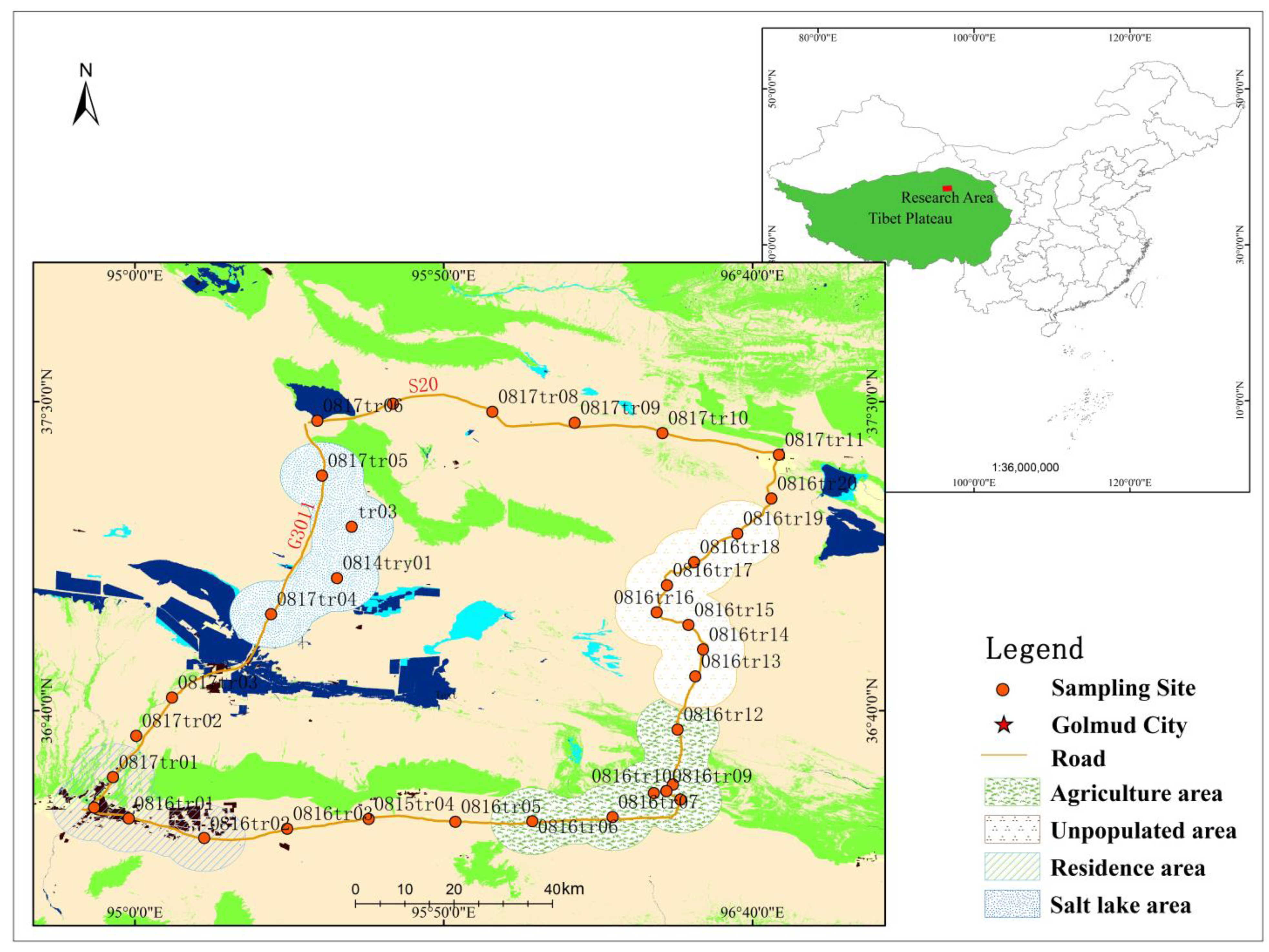
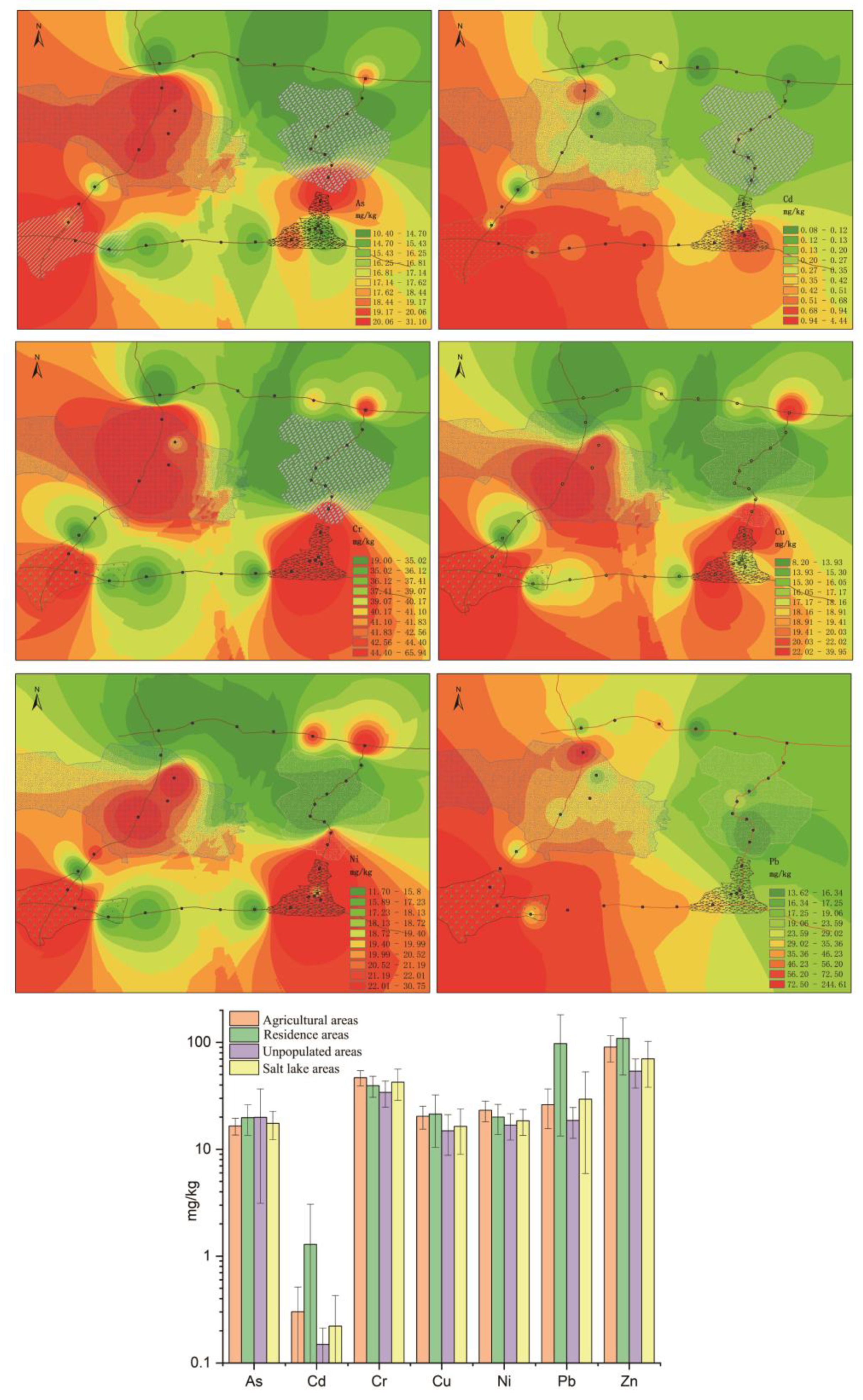
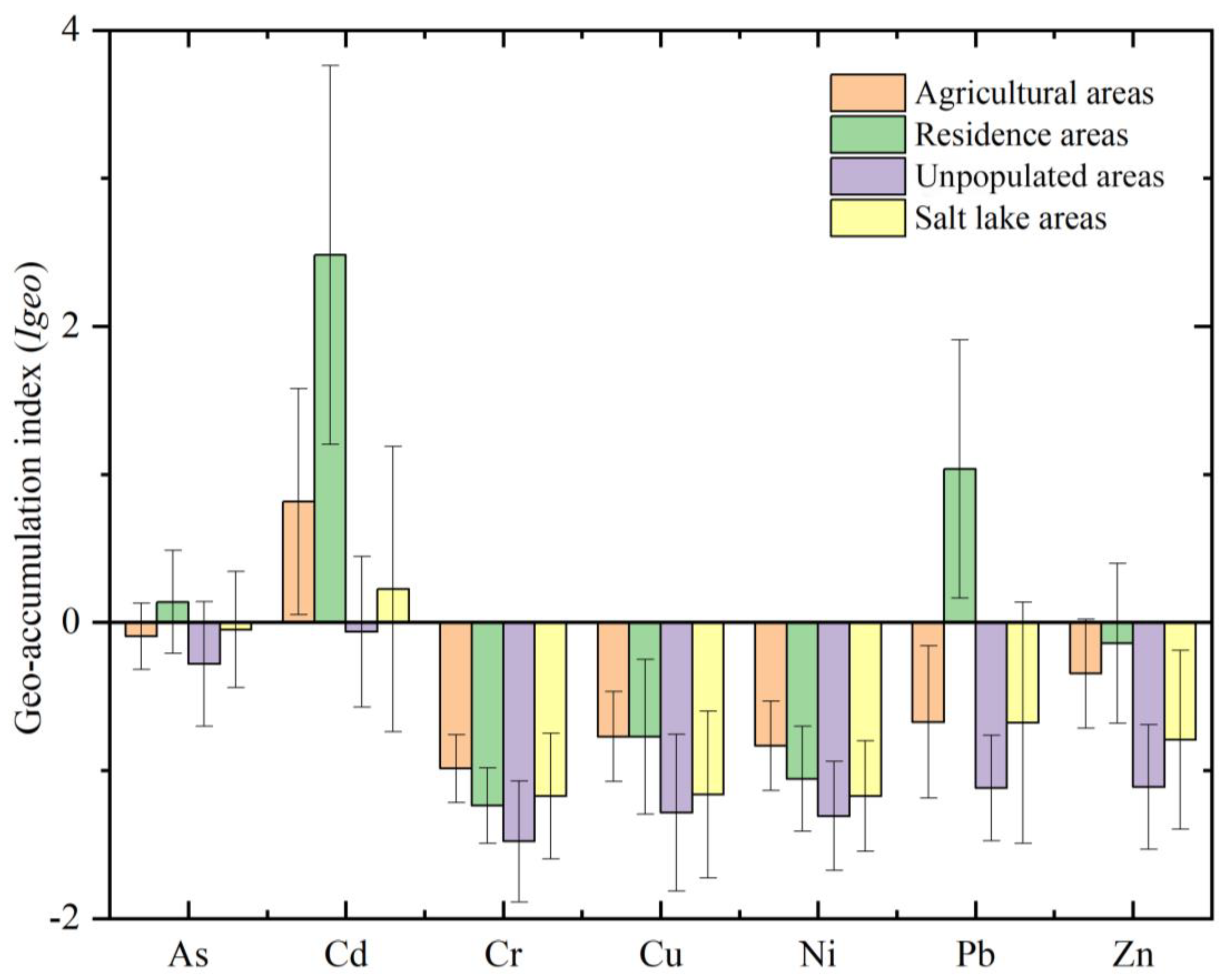
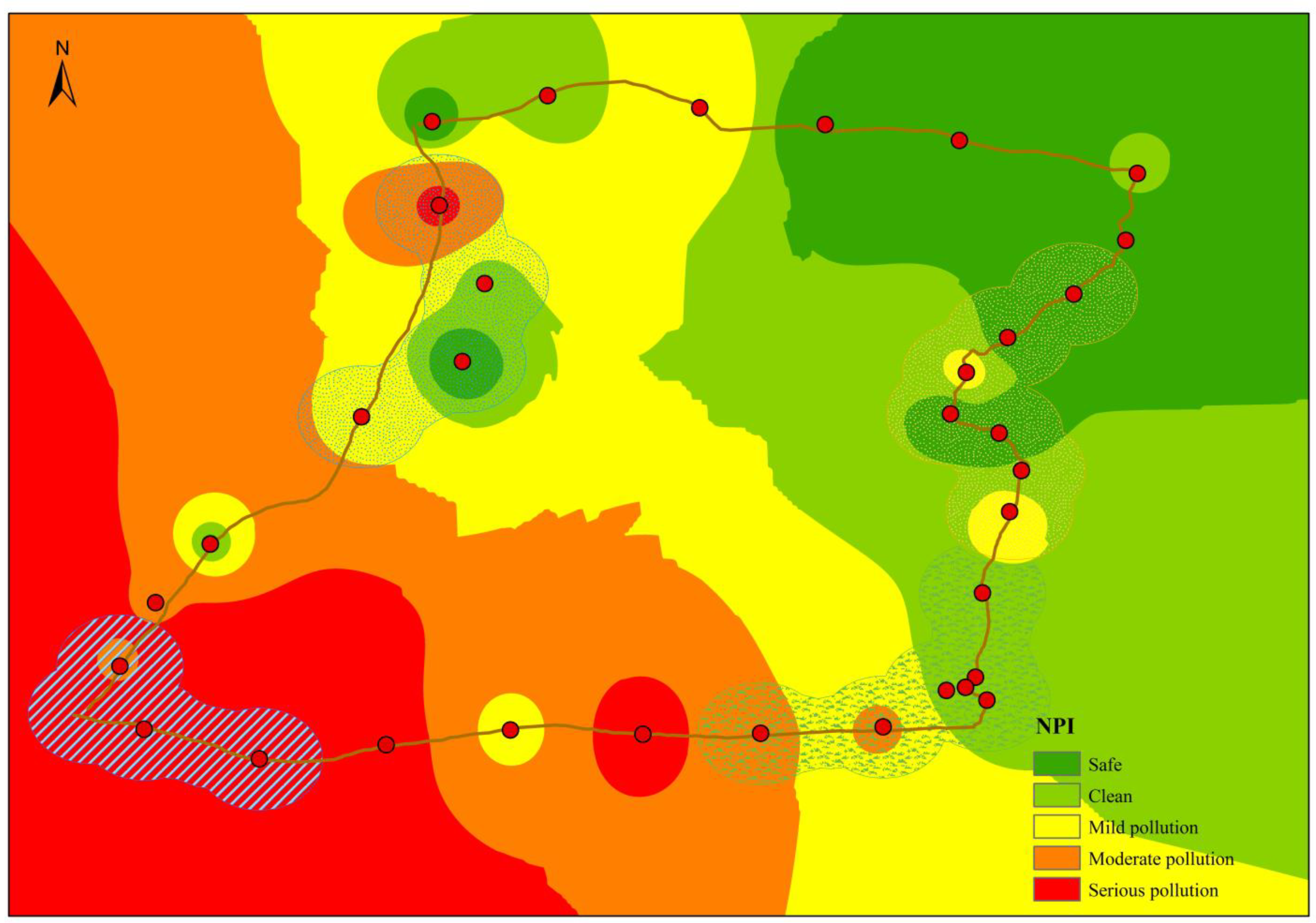
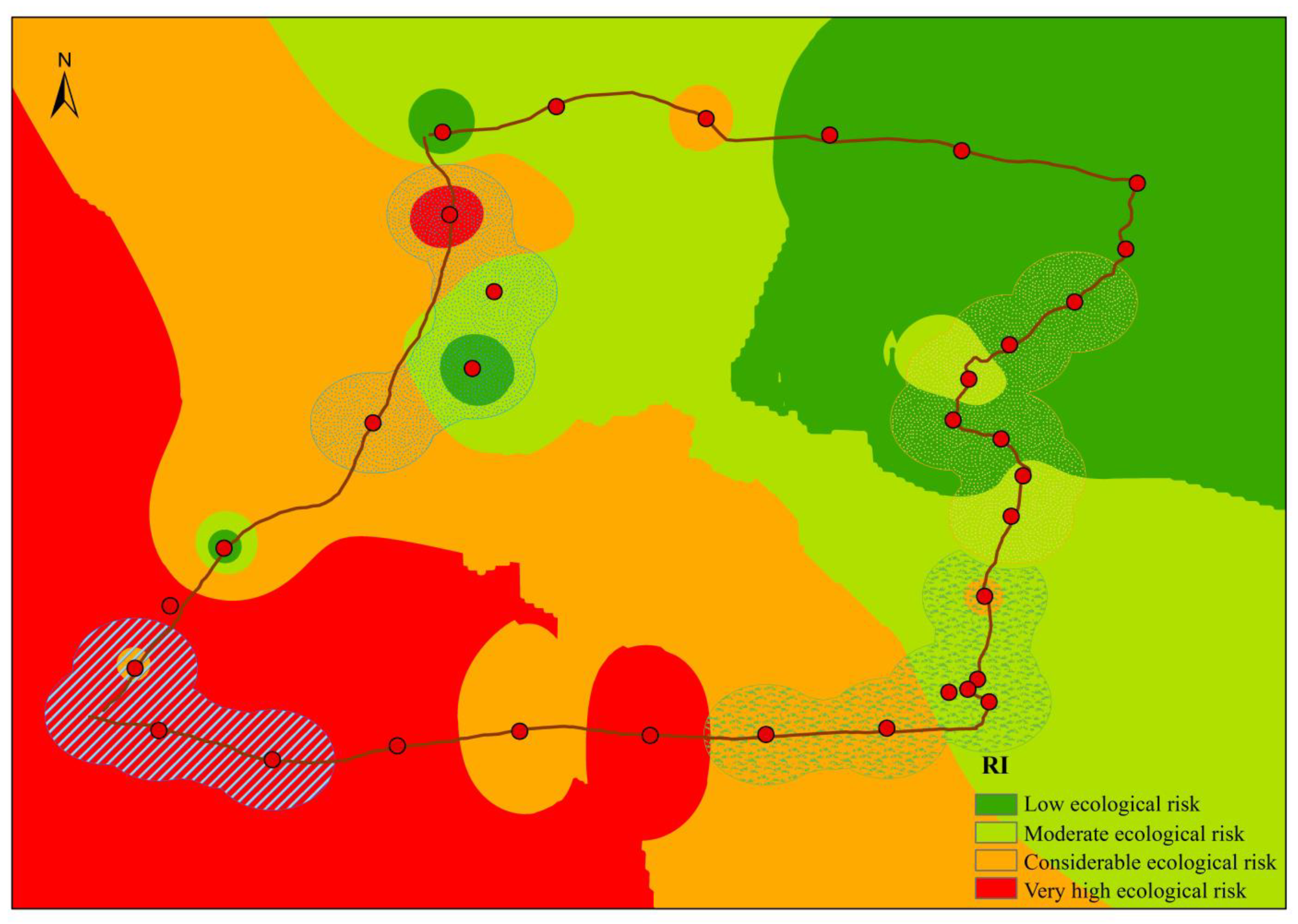
| Igeo | Pi | NPI | RI | ||||
|---|---|---|---|---|---|---|---|
| ≤0 | Unpolluted | ≤1 | Clean | ≤0.7 | Safe | <150 | Low ecological risk |
| 0–1 | Unpolluted to moderately polluted | 1–2 | Mild pollution | 0.7–1 | Clean | 150–300 | Moderate ecological risk |
| 1–2 | Moderately polluted | 2–3 | Moderate pollution | 1–2 | Mild pollution | 300–600 | Considerable ecological risk |
| 2–3 | Moderately to heavily polluted | >3 | Serious pollution | 2–3 | Moderate pollution | ≥600 | Very high ecological risk |
| 3–4 | Heavily polluted | >3 | Serious pollution | ||||
| 4–5 | Heavily to extremely polluted | ||||||
| ≥5 | Extremely polluted | ||||||
| PTE | As | Cd | Cr | Cu | Ni | Pb | Zn |
|---|---|---|---|---|---|---|---|
| Minimum value | 10.4 | 0.08 | 19 | 8.2 | 11.7 | 11.1 | 32 |
| Maximum value | 29.9 | 4.45 | 66 | 40 | 30.8 | 76.8 | 213 |
| Mean value | 18.2 | 0.38 | 39.57 | 17.3 | 19.1 | 34.5 | 75.77 |
| SD | 10.3 | 0.74 | 10.41 | 6.69 | 5.28 | 41.08 | 36.5 |
| Qinghai Province * | 14 | 0.137 | 70.1 | 22.2 | 29.6 | 20.9 | 80.3 |
| China soil * | 11.2 | 0.097 | 61 | 22.6 | 26.9 | 26 | 74.2 |
| Unpopulated Areas | |||||||
|---|---|---|---|---|---|---|---|
| As | Cd | Cr | Cu | Ni | Pb | Zn | |
| As | 1 | −0.229 | 0.733 ** | 0.863 ** | 0.772 ** | −0.260 | 0.498 |
| Cd | 1 | −0.063 | −0.093 | −0.253 | 0.896 ** | 0.553 | |
| Cr | 1 | 0.903 ** | 0.903 ** | 0.060 | 0.712 ** | ||
| Cu | 1 | 0.912 ** | 0.031 | 0.752 ** | |||
| Ni | 1 | −0.195 | 0.578 * | ||||
| Pb | 1 | 0.638 * | |||||
| Zn | 1 | ||||||
| Agricultural areas | |||||||
| As | Cd | Cr | Cu | Ni | Pb | Zn | |
| As | 1 | 0.105 | 0.619 | 0.864 ** | 0.708 * | 0.057 | 0.670 |
| Cd | 1 | −0.410 | 0.029 | −0.322 | 0.878 ** | 0.718 * | |
| Cr | 1 | 0.829 * | 0.973 ** | −0.503 | 0.264 | ||
| Cu | 1 | 0.895 ** | 0.023 | 0.698 | |||
| Ni | 1 | −0.399 | 0.358 | ||||
| Pb | 1 | 0.648 | |||||
| Zn | 1 | ||||||
| Saline lake areas | |||||||
| As | Cd | Cr | Cu | Ni | Pb | Zn | |
| As | 1 | 0.847 * | 0.955 ** | 0.452 | 0.483 | 0.857 * | 0.883 ** |
| Cd | 1 | 0.876 ** | 0.063 | −0.026 | 0.968 ** | 0.742 | |
| Cr | 1 | 0.471 | 0.425 | 0.837 * | 0.942 ** | ||
| Cu | 1 | 0.896 ** | −0.023 | 0.708 | |||
| Ni | 1 | −0.019 | 0.571 | ||||
| Pb | 1 | 0.658 | |||||
| Zn | 1 | ||||||
| Residential areas | |||||||
| As | Cd | Cr | Cu | Ni | Pb | Zn | |
| As | 1 | 0.888 * | 0.743 | 0.852 | 0.778 | 0.945 * | 0.841 |
| Cd | 1 | 0.759 | 0.942 * | 0.752 | 0.967 ** | 0.975 ** | |
| Cr | 1 | 0.923 * | 0.995 ** | 0.828 | 0.750 | ||
| Cu | 1 | 0.917 * | 0.963 ** | 0.946 * | |||
| Ni | 1 | 0.842 | 0.748 | ||||
| Pb | 1 | 0.965 ** | |||||
| Zn | 1 | ||||||
| Unpopulated Areas | Component Matrix | Rotated Component Matrix | ||
|---|---|---|---|---|
| PC1 | PC2 | PC1 | PC2 | |
| As | 0.859 | −0.273 | 0.882 | −0.185 |
| Cd | −0.036 | 0.962 | −0.132 | 0.954 |
| Cr | 0.948 | −0.004 | 0.943 | 0.091 |
| Cu | 0.985 | −0.035 | 0.984 | 0.065 |
| Ni | 0.931 | −0.233 | 0.949 | −0.139 |
| Pb | 0.048 | 0.981 | −0.051 | 0.981 |
| Zn | 0.777 | 0.615 | 0.711 | 0.690 |
| Agricultural areas | Component matrix | Rotated component matrix | ||
| PC1 | PC2 | PC1 | PC2 | |
| As | 0.870 | 0.237 | 0.872 | 0.232 |
| Cd | −0.098 | 0.959 | −0.092 | 0.959 |
| Cr | 0.905 | −0.366 | 0.903 | −0.372 |
| Cu | 0.978 | 0.157 | 0.979 | 0.151 |
| Ni | 0.950 | −0.260 | 0.949 | −0.266 |
| Pb | −0.165 | 0.953 | −0.159 | 0.954 |
| Zn | 0.591 | 0.795 | 0.596 | 0.791 |
| Saline lake areas | Component matrix | Rotated component matrix | ||
| PC1 | PC2 | PC1 | PC2 | |
| As | 0.977 | −0.063 | 0.894 | 0.398 |
| Cd | 0.849 | −0.515 | 0.992 | −0.062 |
| Cr | 0.986 | −0.077 | 0.909 | 0.390 |
| Cu | 0.546 | 0.815 | 0.105 | 0.975 |
| Ni | 0.500 | 0.825 | 0.059 | 0.963 |
| Pb | 0.818 | −0.555 | 0.982 | −0.112 |
| Zn | 0.959 | 0.179 | 0.766 | 0.604 |
| Residential areas | Component matrix | |||
| PC1 | ||||
| As | 0.915 | |||
| Cd | 0.953 | |||
| Cr | 0.906 | |||
| Cu | 0.991 | |||
| Ni | 0.911 | |||
| Pb | 0.986 | |||
| Zn | 0.944 | |||
| PTEs | Pi | Distribution of Pi (%) | |||||
|---|---|---|---|---|---|---|---|
| Minimum Value | Maximum Value | Average Value | Clean (Safe) | Mild Pollution | Moderate Pollution | Severe Pollution | |
| As | 0.93 | 2.79 | 1.45 | 2.86 | 85.71 | 11.43 | - |
| Cd | 0.82 | 45.88 | 3.91 | 11.43 | 45.71 | 17.14 | 25.71 |
| Cr | 0.31 | 1.08 | 0.65 | 97.14 | 2.86 | - | - |
| Cu | 0.36 | 1.77 | 0.77 | 82.86 | 17.14 | - | - |
| Ni | 0.43 | 1.14 | 0.71 | 91.43 | 8.57 | - | - |
| Pb | 0.43 | 3.13 | 1.06 | 65.71 | 20.00 | 8.57 | 5.71 |
| Zn | 0.43 | 2.87 | 1.02 | 60.00 | 37.14 | 2.86 | - |
Publisher’s Note: MDPI stays neutral with regard to jurisdictional claims in published maps and institutional affiliations. |
© 2022 by the authors. Licensee MDPI, Basel, Switzerland. This article is an open access article distributed under the terms and conditions of the Creative Commons Attribution (CC BY) license (https://creativecommons.org/licenses/by/4.0/).
Share and Cite
Ma, Y.; Wang, Q.; Su, W.; Cao, G.; Fu, G.; Du, W. Potential Sources, Pollution, and Ecological Risk Assessment of Potentially Toxic Elements in Surface Soils on the North-Eastern Margin of the Tibetan Plateau. Toxics 2022, 10, 368. https://doi.org/10.3390/toxics10070368
Ma Y, Wang Q, Su W, Cao G, Fu G, Du W. Potential Sources, Pollution, and Ecological Risk Assessment of Potentially Toxic Elements in Surface Soils on the North-Eastern Margin of the Tibetan Plateau. Toxics. 2022; 10(7):368. https://doi.org/10.3390/toxics10070368
Chicago/Turabian StyleMa, Yujun, Qiugui Wang, Weigang Su, Guangchao Cao, Guoyan Fu, and Wen Du. 2022. "Potential Sources, Pollution, and Ecological Risk Assessment of Potentially Toxic Elements in Surface Soils on the North-Eastern Margin of the Tibetan Plateau" Toxics 10, no. 7: 368. https://doi.org/10.3390/toxics10070368
APA StyleMa, Y., Wang, Q., Su, W., Cao, G., Fu, G., & Du, W. (2022). Potential Sources, Pollution, and Ecological Risk Assessment of Potentially Toxic Elements in Surface Soils on the North-Eastern Margin of the Tibetan Plateau. Toxics, 10(7), 368. https://doi.org/10.3390/toxics10070368





